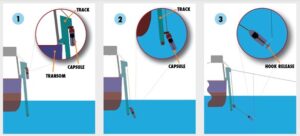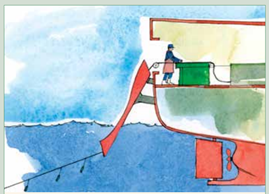Underwater Bait Setting
WHAT IS UNDERWATER BAIT SETTING?
Seabirds are at greatest risk of becoming hooked and drowned when foraging during the short period between when hooks leave the vessel, and when they sink beyond seabirds’ diving ranges. In an attempt to reduce the incidence of seabird bycatch in longline fisheries, devices have been designed to deploy baited hooks underwater, beyond the dive depths of seabirds (6-10m). One of the designs, the underwater bait setter, works by deploying the baited hook underwater through the sling-shot action of a capsule released from the deck (see image 1). This technology works on a hydraulic system controlled by an on-board computer.
An alternative design – the underwater setting chute – also releases bait underwater, but in place of a capsule which individually deploys hooks, a chute is attached to the stern of the vessel and descends down under the water carrying the whole set of baited hooks off the back of the boat and under the sea, safely out of reach of diving seabirds.
Releasing bait underwater using these devices reduces the incidence of hooking seabirds, and additionally prevents the loss of bait to seabirds that successfully fly away with it, further improving catch rates of target species. However, these different underwater bait setting techniques currently demonstrate varying levels of success, and so should be used in combination with bird-scaring lines, night setting and line weighting.

Underwater Bait Setter. Source: SkadiaTech

Underwater setting chute. Source: BLI
CURRENT RESEARCH & USE
Trials of the underwater bait setter commenced in 2010 in the Uruguayan pelagic longline fishery, and were repeated in 2012. When compared with baited hooks deployed at the surface, baited hooks released 4m underwater reduced seabird mortality by 87%; when released 10m underwater, seabird mortality was reduced to zero. Underwater bait setters are commercially produced by Skadia Technologies and supported by the Australian Government and the Department of Conservation in New Zealand (amongst others).
Underwater setting chutes have been trialled in multiple fisheries. Trials in the Alaskan demersal cod fishery reported reduced bycatch of 79% (mostly of Northern Fulmars, a surface feeding species). Separate trials conducted in the Patagonian Toothfish demersal longline fishery found that, when used in conjunction with bird-scaring lines,, the addition of the chutes reduced the bycatch rate threefold. It has been noted, however, that in rough seas the existing chute design is not sturdy enough to be reliably effective as it can be lifted clear of the water as the boat pitches.
Although these devices have so far shown potential as bycatch mitigation strategies, they are still considered to be under development and further trials are ongoing.
This page was last updated on 12.02.21.
Interested in how this and other measures could mitigate bycatch in your fishery? Get in touch with us to collaborate or take part in a study.
